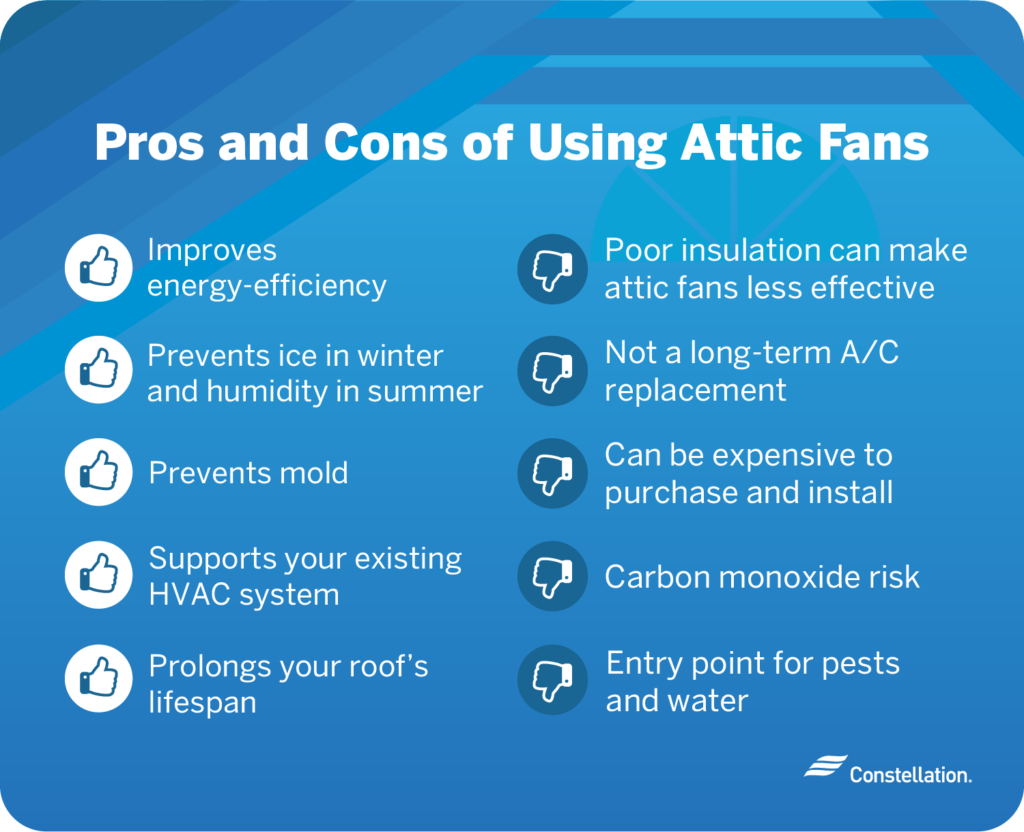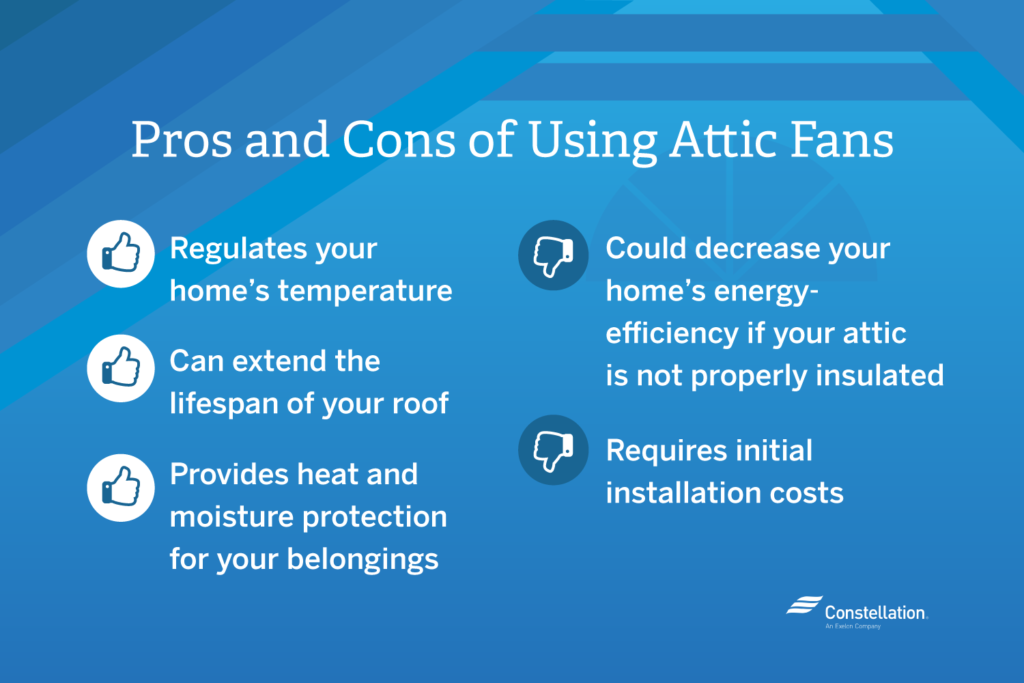Pros And Cons Of Attic Fans

Attic Fans: A Comprehensive Guide to Cooling Your Home
Attic fans, also known as roof fans or gable fans, are designed to ventilate your attic space, helping to regulate temperature and moisture levels. They can be a valuable addition to any home, but understanding their pros and cons is essential before making a purchase.
What is an Attic Fan and How Does It Work?
An attic fan is a ventilation device installed in the attic of a building. Its primary function is to exhaust hot air from the attic, preventing it from radiating down into the living spaces below. This process helps to reduce the load on your air conditioning system, potentially lowering energy bills. There are primarily two types of attic fans:
- Whole-house fans: These fans pull air from inside the house and exhaust it into the attic.
- Attic vent fans: These fans exhaust only the hot air that is already in the attic.
Most attic fans are thermostatically controlled, meaning they automatically turn on when the attic temperature reaches a certain point. Some models also include humidistats to address moisture concerns.
Pros of Installing an Attic Fan
Attic fans offer a range of benefits, including:
- Reduced Energy Consumption: By removing hot air from the attic, attic fans can significantly lower the demand on your air conditioner. This is especially true in hot climates. With the attic cooler, your AC unit doesn't have to work as hard to maintain a comfortable temperature in your home.
- Lower Cooling Costs: The reduction in AC usage directly translates to lower energy bills. The savings can be substantial, especially during peak summer months.
- Extended Roof Lifespan: Excessive heat and moisture can damage roofing materials, leading to premature wear and tear. By improving ventilation, attic fans help to prevent overheating and moisture buildup, prolonging the life of your roof.
- Improved Indoor Comfort: A cooler attic contributes to a more comfortable living environment, especially in upstairs rooms that are directly below the attic.
- Moisture Control: Attic fans help to prevent moisture accumulation, reducing the risk of mold and mildew growth. This is particularly important in humid climates or homes with poor attic ventilation.
- Prevent Ice Dams: In colder climates, attic fans can help prevent ice dams by keeping the roof temperature more consistent. This prevents snow from melting and refreezing at the eaves, forming ice dams that can damage the roof.
Cons of Installing an Attic Fan
Despite their benefits, attic fans also have potential drawbacks:
- Potential for Air Conditioning Leakage: If not properly installed or if the house is not adequately sealed, attic fans can draw conditioned air from the living spaces into the attic and exhaust it outside. This can negate the energy savings and even increase cooling costs.
- Increased Heating Costs in Winter: In colder months, attic fans can exhaust warm air from the house, increasing heating costs. It’s crucial to ensure that the fan is either turned off or has a winter setting that prevents it from running unnecessarily.
- Noise: Some attic fans can be quite noisy, especially older models or those with poorly balanced blades. This can be disruptive, particularly if the fan is located near bedrooms or living areas.
- Maintenance: Attic fans require regular maintenance, including cleaning the blades and motor to ensure optimal performance. Failure to maintain the fan can lead to reduced efficiency and increased noise.
- Cost of Installation: Installing an attic fan can be expensive, especially if electrical work is required. The cost of the fan itself and the installation labor can add up.
- Negative Pressure Concerns: Improperly installed or oversized attic fans can create negative pressure in the house, potentially drawing in radon gas or backdrafting combustion appliances like furnaces or water heaters. It's essential to ensure proper ventilation throughout the house to avoid these issues.
Types of Attic Fans
There are several types of attic fans available, each with its own advantages and disadvantages:
- Roof-Mounted Attic Fans: These fans are installed directly on the roof, typically near the ridge. They are effective at exhausting hot air but require professional installation.
- Gable-Mounted Attic Fans: These fans are installed in the gable vents of the attic. They are generally easier to install than roof-mounted fans but may not be as effective at ventilating the entire attic space.
- Solar-Powered Attic Fans: These fans are powered by solar panels, offering an environmentally friendly and energy-efficient option. However, their performance depends on the amount of sunlight available.
- Whole House Fans: While often confused with attic fans, whole-house fans are different. They pull air from the living space and exhaust it into the attic, requiring open windows for proper function.
Key Features to Consider
When choosing an attic fan, consider the following features:
- Airflow Capacity (CFM): The airflow capacity, measured in cubic feet per minute (CFM), determines how much air the fan can move. Choose a fan with a CFM rating appropriate for the size of your attic. A general guideline is to have a fan that can replace the air in your attic 10-15 times per hour.
- Thermostat and Humidistat: A thermostat allows the fan to automatically turn on when the attic reaches a certain temperature. A humidistat monitors humidity levels and activates the fan when necessary, preventing moisture buildup.
- Energy Efficiency: Look for fans with energy-efficient motors and designs to minimize energy consumption. Consider models with Energy Star certification.
- Noise Level: Check the fan's noise rating before purchasing. Choose a quieter model if noise is a concern.
- Durability and Warranty: Select a fan made from durable materials and backed by a solid warranty.
- Installation Requirements: Consider the installation requirements and whether you can install the fan yourself or if you'll need to hire a professional.
Popular Brands and Models
Several reputable manufacturers offer high-quality attic fans. Here are a few popular brands and models:
- Broan-NuTone: Offers a range of attic ventilation products, including roof-mounted and gable-mounted fans. Known for their durability and reliability.
- GAF: Primarily known for roofing products, GAF also offers solar-powered attic fans.
- Solar Star: Specializes in solar-powered attic fans with various CFM ratings.
- QuietCool: While primarily known for whole house fans, they also offer attic vent fans with focus on quiet operation.
When comparing models, pay attention to specifications such as CFM, voltage, and warranty details. Customer reviews can also provide valuable insights into the performance and reliability of different brands and models.
Pricing and Installation Costs
The cost of an attic fan can vary depending on the type, size, and features. Gable-mounted fans typically range from $50 to $200, while roof-mounted fans can cost between $150 and $500 or more. Solar-powered attic fans tend to be more expensive, ranging from $300 to $800. Installation costs can also vary depending on the complexity of the job and the electrician's hourly rate. Professional installation can add anywhere from $100 to $500 or more to the overall cost.
Warranty and Maintenance
Most attic fans come with a manufacturer's warranty that covers defects in materials and workmanship. The length of the warranty can vary, so be sure to check the details before purchasing. Regular maintenance is essential to ensure optimal performance and prolong the life of your attic fan. This includes cleaning the blades and motor to remove dust and debris. Lubricating the motor bearings may also be necessary, depending on the model. Inspect the fan regularly for any signs of damage or wear and tear.
Is an Attic Fan Right for Your Home?
Deciding whether or not to install an attic fan depends on several factors, including:
- Climate: Attic fans are most beneficial in hot climates where cooling costs are high.
- Attic Ventilation: If your attic already has adequate natural ventilation, an attic fan may not be necessary.
- Home Sealing: Ensure your home is properly sealed to prevent conditioned air from being drawn into the attic.
- Budget: Consider the cost of the fan, installation, and ongoing maintenance.
Ultimately, the best way to determine if an attic fan is right for your home is to consult with a qualified HVAC professional. They can assess your specific needs and recommend the best solution for your situation. Remember to consider all the pros and cons, weigh your options carefully, and choose a fan that meets your requirements and budget.
While AFUE, SEER, and HSPF ratings are more relevant to furnaces, air conditioners, and heat pumps, understanding the energy efficiency of your attic fan is still important. Look for Energy Star-certified models to minimize energy consumption.




:max_bytes(150000):strip_icc()/whole-house-fan-vs-attic-fan-final-74f06c2a6870455f8e6caad8fd7c2997.png)





